Spotify Ad Studio Revisited
Spotify launched their Ad Studio platform early last year. I was giddy with excitement.
For the first time, I could make potential fans hear my music. If they liked it enough to click through, my entire catalog was at their fingertips, AND I’d earn royalties on every play. Maybe I’d even earn enough to pay for the ads! What could be better?
My results, for one. It’s hard to see how they could’ve been worse.
I chalked it up to a lack of targeting options. I wasn’t able to target fans of specific bands, or even reach my own fans. Instead I was stuck targeting the overly broad and ambiguous “Electronica” genre. I’m not sure what “electronica” even means these days, but that was clearly the closest option to synthwave.
Recently I learned that you can now target fans of specific bands. The giddiness returned.
Was my enthusiasm justified? Read on.
My Spotify ad
I’m not going to walk you through the ad creation process like I did last time, since little has changed.
Instead I’ll share my ad and the thinking behind it. It’s pretty straightforward.
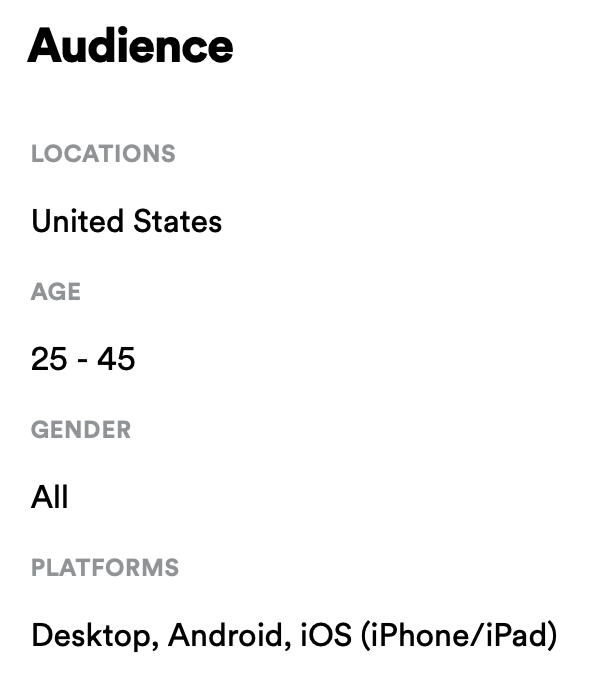
I left the high-level targeting rather broad, because last time I didn’t see any benefit to further restricting age, gender, or platform.
This time I was able to specifically target fans of The Midnight, who are the center of the synthwave bullseye for me. Most synthwave is instrumental, so being able to reference another artist with male vocals and a focus on solid songwriting was exactly what the doctor ordered.
One cool feature of Ad Studio is that they’ll record your ad for you if you provide the script. Last time I did it myself, but I figured a female voice would prove more enticing to the overwhelmingly male synthwave fanbase.
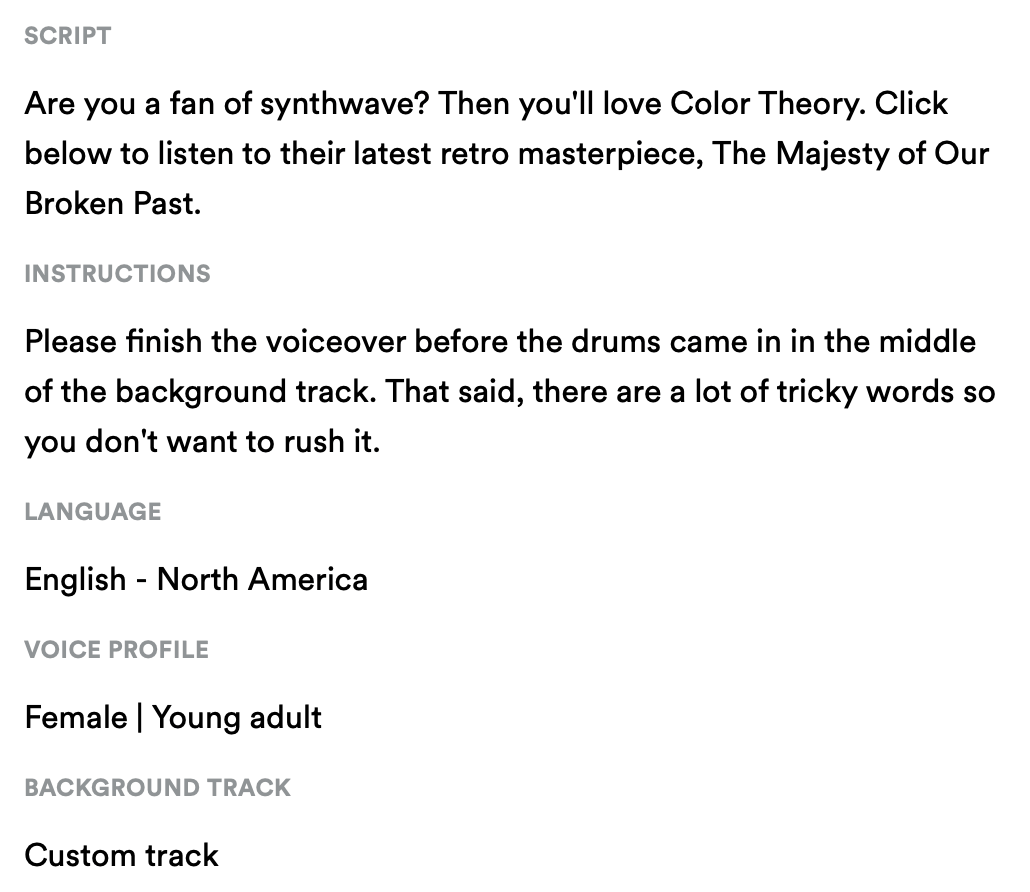
Here’s how it turned out:
I don’t see how the ad could be any better:
- It immediately calls out the target audience (synthwave fans)
- The music sounds just like The Midnight
- The artwork screams synthwave
If you disagree, let me know how I can improve on it and maybe I’ll try out your suggestions!
Here’s how the ad looked on mobile:

In a word, glorious. Let the clicking commence!
A false start
The first version of this article was posted a month and a half ago. My results were pathetic due to a bug in their platform that switched the targeting from “The Midnight” to “Genre – All”.
Luckily, you can stop ad delivery any time you want, without exhausting your entire budget.

Here are my “Genre – All” results after five days, at which point I pulled the plug:
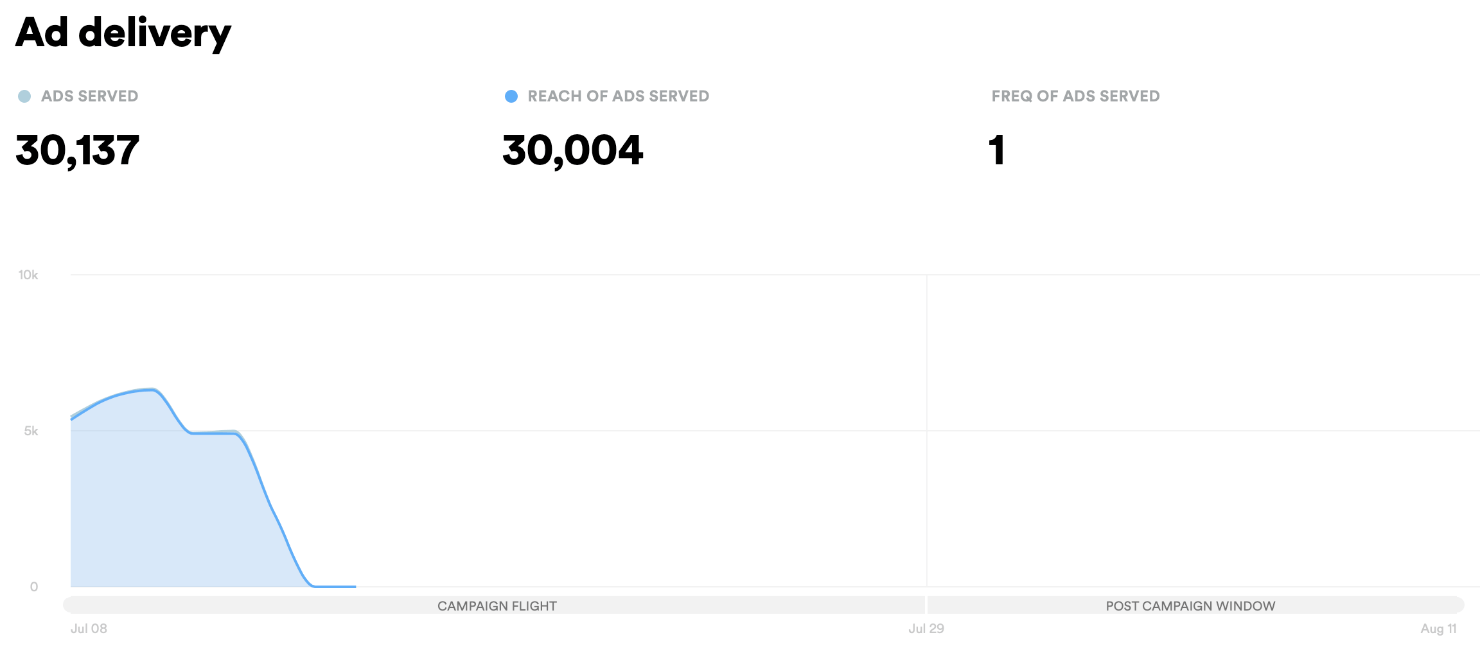
What percentage of listeners would you guess clicked through? 10%? 2%? Nope.
Not even one-tenth of one percent.
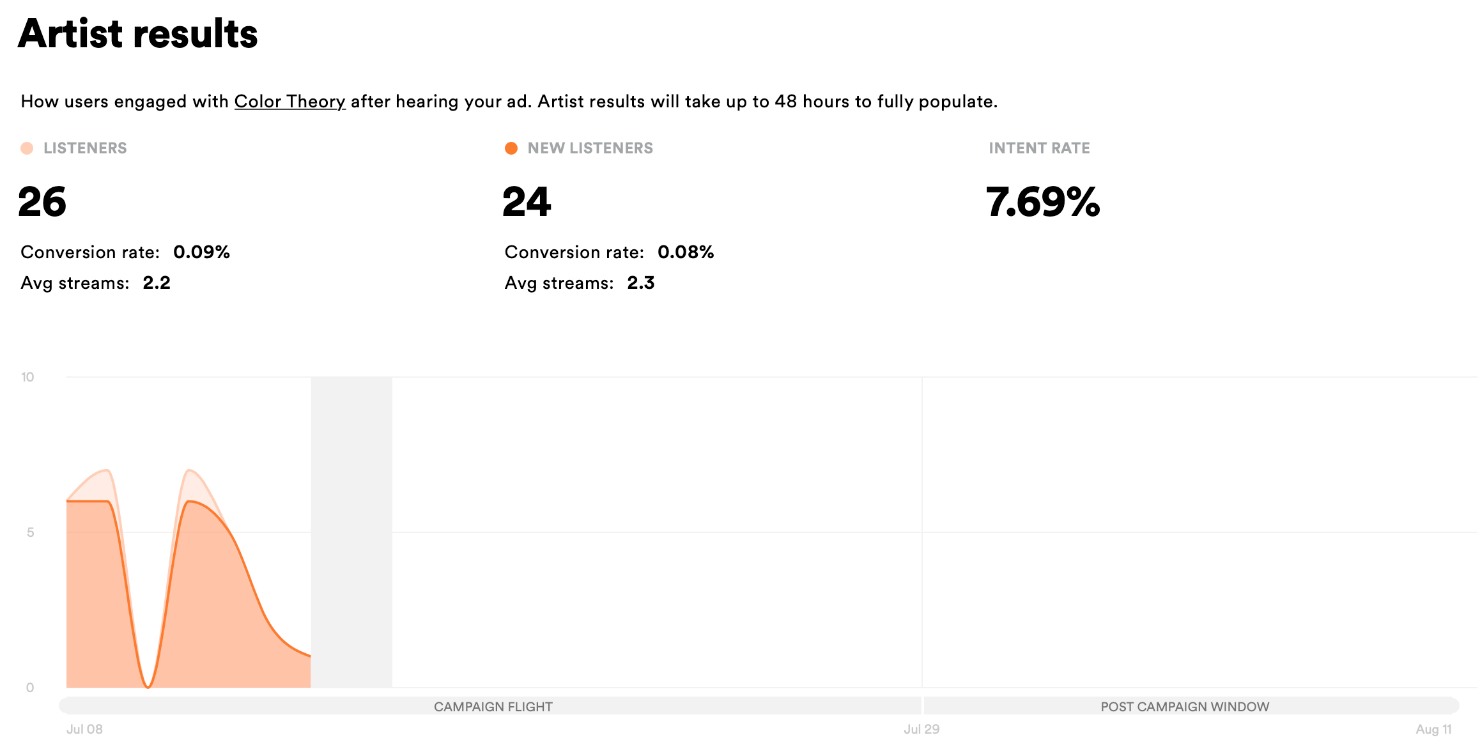
24 new listeners, meaning people who hadn’t listened to my music in the past 28 days, listened to an average of 2.3 songs. That’s 55 streams for nearly $80.
Hours after the post went live, support let me know about the bug, and eventually refunded the $80 I spent.
My Spotify Ad Studio results
It took a few days to get another ad up and running, because the same script I used in my first ad was rejected.
That one started off with, “Are you a fan of The Midnight?”
I mean, how perfect is that? The answer has to be “yes” because my target is… fans of The Midnight.
Turns out I had to settle for less than perfection:
Your voiceover can only mention artists whose content is being promoted. Remove the mention of all artists whose music is not being promoted from your audio voiceover.
Makes you wonder why the first ad was approved, or why the voiceover team recorded it in the first place. I’ve seen Spotify ads tutorials that call out other artists by name!
Despite that handicap, I was still quite pleased with the results.

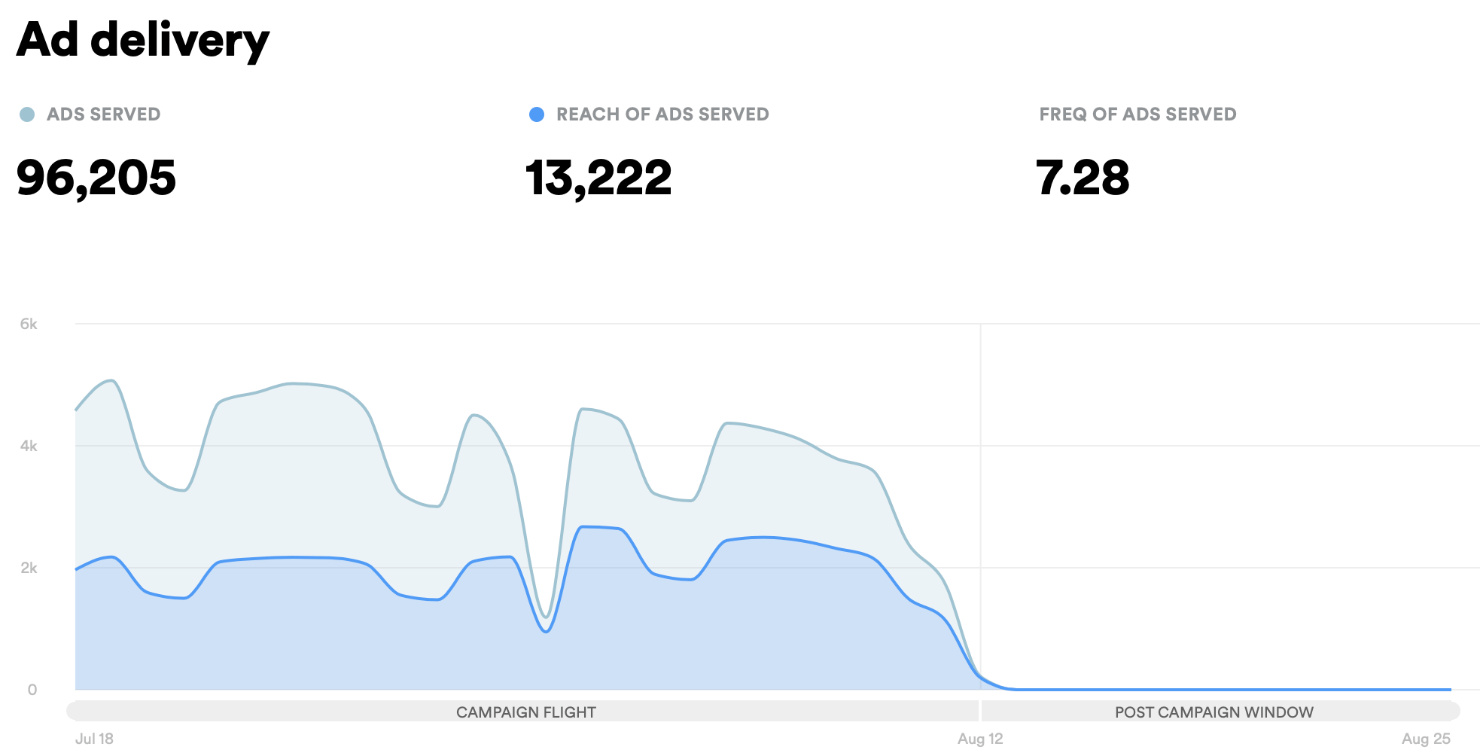
What jumped out at me is the frequency. With Facebook Ads, I’ll typically disable an ad set long before the frequency gets that high.
I emailed support to ask what I could do to bring it down. Here is their response:
Yes, that frequency is higher than the average we would see (2-3). This is the average over the lifetime of the campaign however. We have a cap in place on a daily level so as not to play too much to the same user. If you wish to bring down the frequency, I would recommend opening up the targeting. The ad is delivering at a higher frequency because this audience is on the smaller side. Here are some options:
• Changing fan targeting to genre targeting. I’m aware however that you may not want to do this based on our discussions about your previous ad.
• Add some other artists to fan targeting that would be similar to The Midnight. Adding some artists with larger listenership but a similar audience/style would help a lot.
• Open up the age targeting.Give one of those a try and hopefully it will help with the frequency.
So on July 30 (about halfway through the campaign), I added several other synthwave artists:

It didn’t really help, likely because everyone who is a fan of those other artists is also a fan of The Midnight. They are to synthwave what Nirvana is to grunge, Metallica is to metal, Star Wars is to sci-fi, Tolkien is to fantasy, and Kermit is to frog puppets.
Frequency woes aside, here’s what $250 got me:
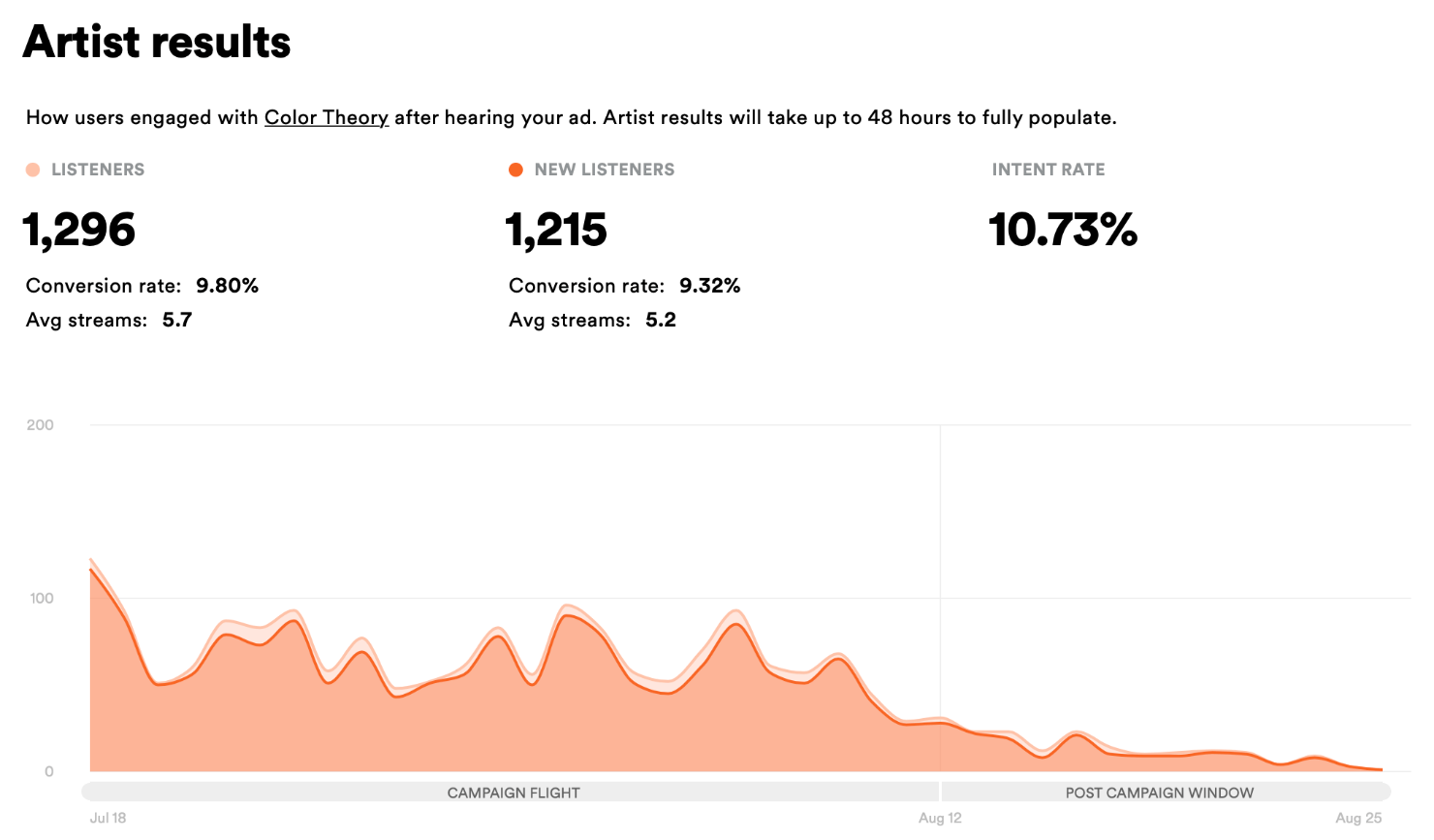
Are you impressed? I’m impressed!
Let’s do a little back-of-the-envelope math:
1300 new listeners x 6 streams per listener = 7800 streams x $0.004 per stream = $31
I didn’t expect the streams to pay for the campaign, but hey, they covered about an eighth of it!
The post campaign window is intriguing. If I’m understanding it correctly, people heard my ad during the campaign, and then listened to my music as much as two weeks later.
Did they just happen to remember to look me up? That strikes me as unlikely. I emailed support for clarification, because I didn’t see anything in the FAQ. Their response:
Correct, we have a two week attribution window. So if someone who heard your ad listens to your music up to 2 weeks after the ad played, they will be attributed as a new listener from your ad. This would be common practice in a lot of advertising including display ads you would see on Facebook, Google, etc. Listeners may not always click on your ad there and then as they may not be able to (driving, working out, etc while listening) but our research has shown that they may listen to your music at a later date.
Now that I think about it, that makes sense. I often save stuff I read about online to a “check out” playlist to peruse later.
A solid percentage of those new listeners likely became new followers, as my follower count went up quite a bit:
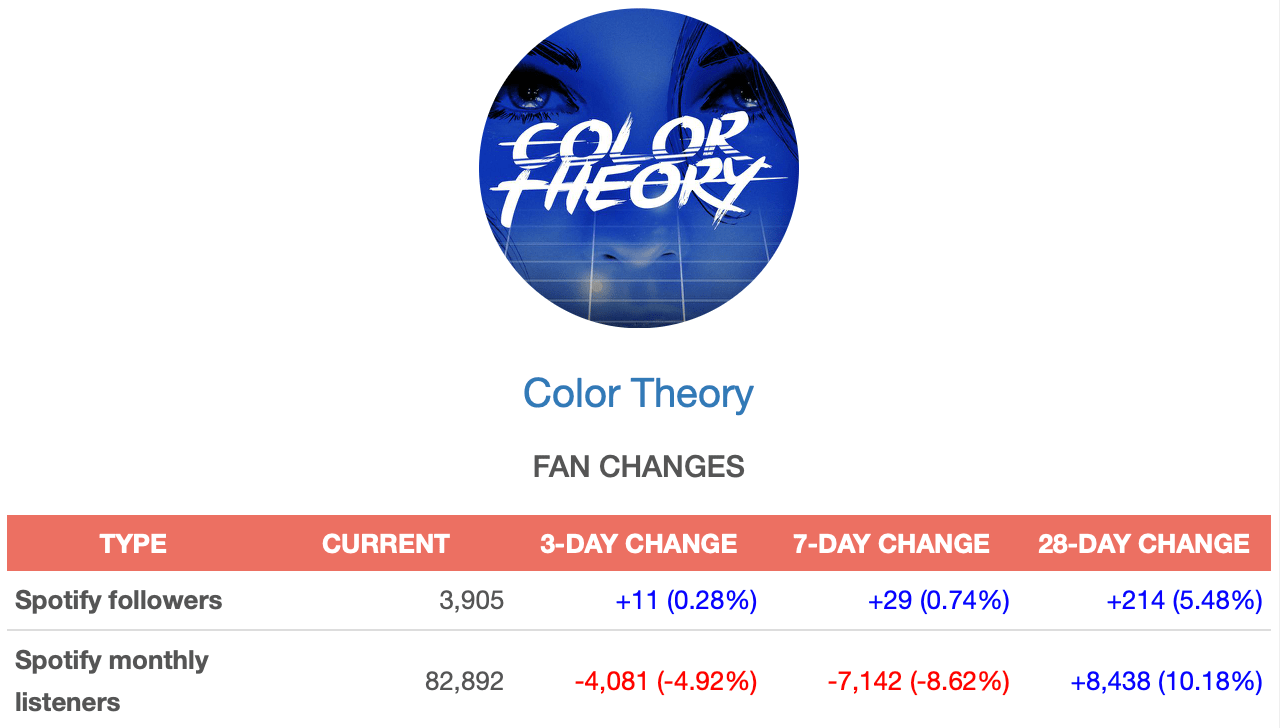
I can’t attribute that all to the ad campaign though, as I’ve been running multiple Spotify PR campaigns. Details to come!
Intent rate is defined in the FAQ as: “The percentage of listeners who took actions showing intent to stream the artist again in the future. Actions include saving the artist’s music (by tapping the heart icon or “save”) or adding it to a playlist.”
I’m not sure if 11% is good or bad. Let’s compare notes!
Finally, here’s who my ad was served to. Recall that I restricted age to 25-45.
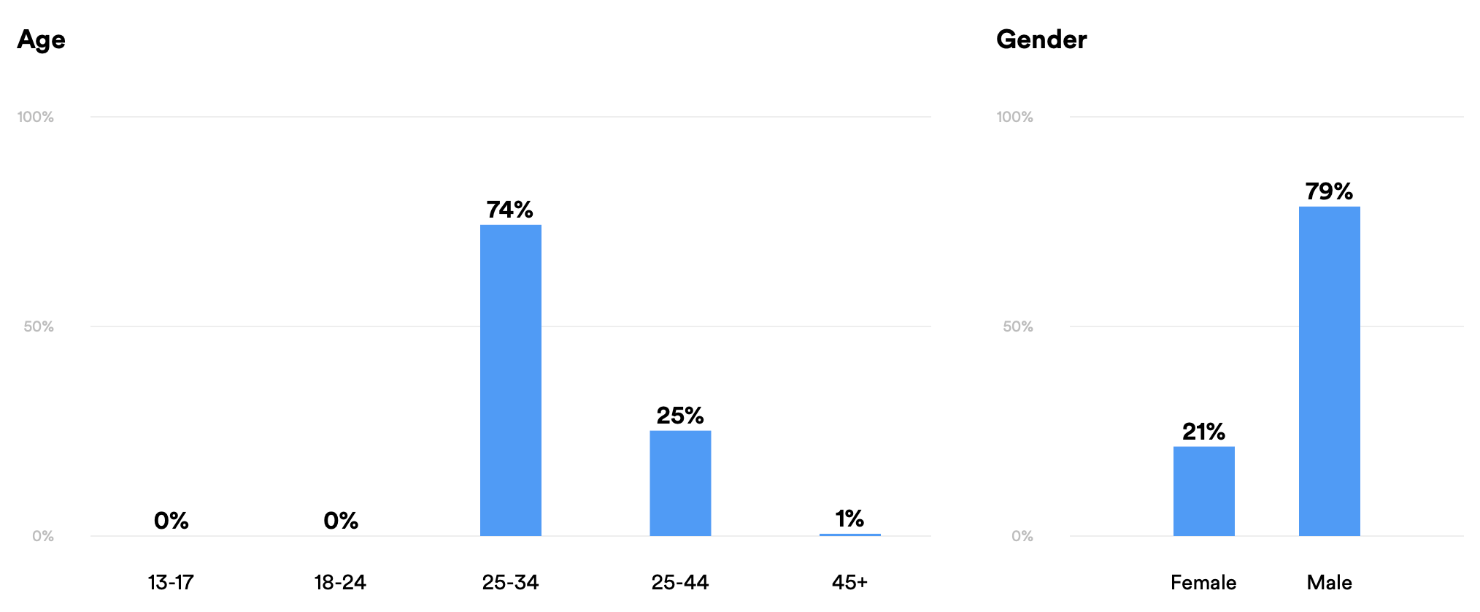

In summary, the usual synthwave sausage-fest. Last I checked Facebook Audience Insights, synthwave fans are 90% male.
Spotify Ads Studio conclusion
The moral of the story is: targeting matters.
Specifically, appropriate targeting brought my 0.09% conversion rate up to 9.80%, and my “stay away from Spotify Ad Studio at all costs” recommendation up to “give it a shot!”
I’ll be doing just that in a couple weeks with a new 4-track single, and if that produces positive results, with a new album in October.
I’ve got a couple suggestions to improve the platform for artists:
- Swap out the vague Intent Rate metric in favor of New Followers, Song Saves, and Playlist Adds.
- Include our music in the Discovery Weekly playlists of the listeners who hear our ads. Conversion rates would go through the roof!
- Integrate Ad Studio reporting with the Spotify for Artists dashboard
Feel free to add your own suggestions, and share your results, in the comments!


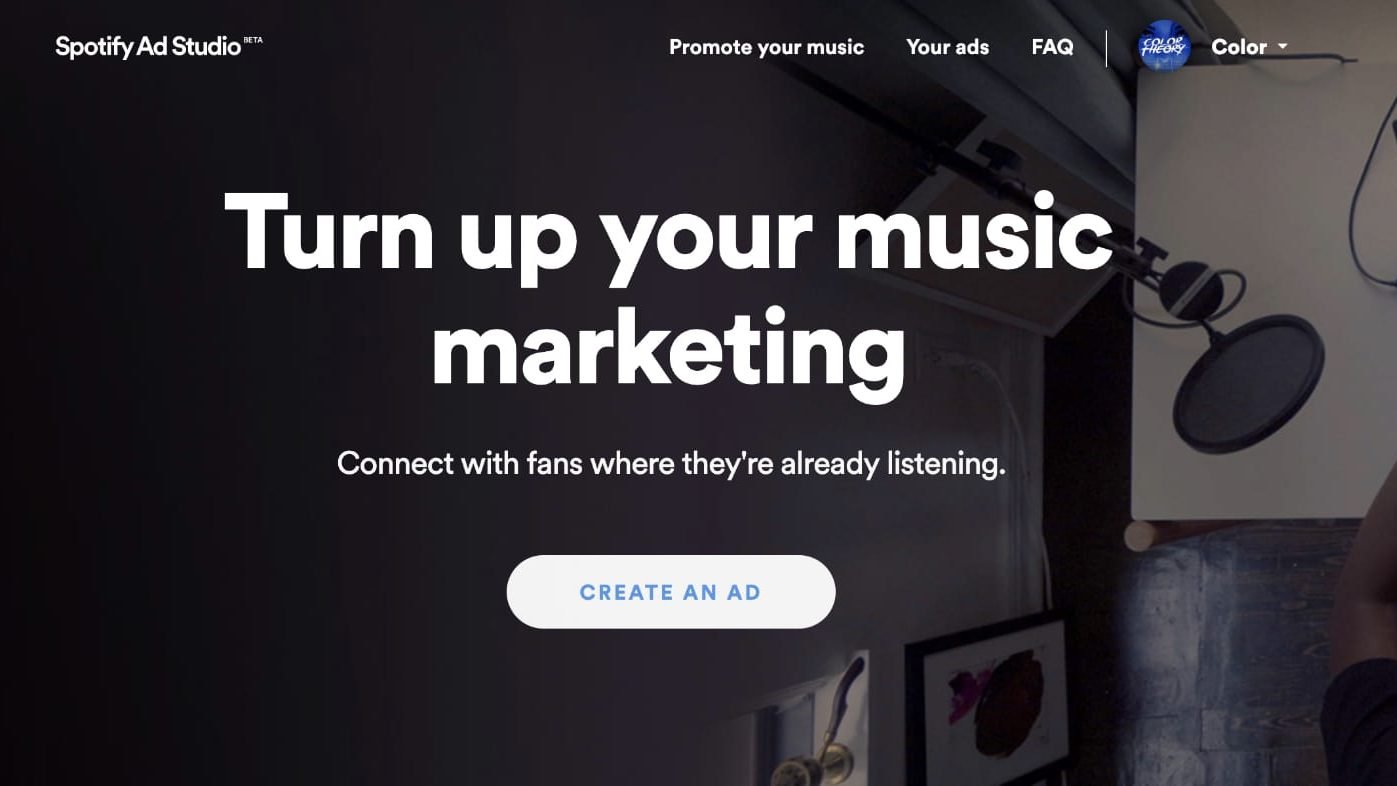
Did they refund your $80?
I requested a refund, but I haven’t heard back. Technically I haven’t paid for it yet, so maybe they’ll just void the entire campaign.
Hey Brian – in your last mail out you mentioned you’re working with a Spotify PR service. I expect you’ll be covering that experience once results are in but wondering if you’re willing to mention which service you went with ?
Thanks!
I’ve run two campaigns with two different services: Virtuoso and Midnite Blaster (who I also wrote about SoundCloud promo with).
Hi Brian, would you please tell us about your experience with Virtuoso? Thanks.
I will be writing about it in great detail! Hopefully in the next few weeks.
Thanks, Brian. We’re anxiously waiting for your review. And we owe you a huge debt ♥️
I’ve now run 2 ad’s and my conversion has been .22% and .32%. I know my ad’s aren’t bad because I’ve run them on Facebook targetting the same artist. I contacted Spotify and they ensured me that the ad wasn’t accidentally targetting “all genres” like your original one did. I’ve spent a total of $270 for 120 POTENTIAL new fans and none of the streams are getting me paid. I don’t know how you’re getting such good numbers but I would like to see what your final campaign results look like. Any updates would be great cause I’m close to giving up on them completely.
Just updated the post with my latest results!
You can confirm the targeting on the ad details page. It’s in the right sidebar.
I’d be extremely happy with those results. Congrats! Hopefully it leads to some consistent growth.
Thanks for the great article and congrats for the blog :)!
I like your suggestions but as much as it would be awesome as a musician to get your stuff in the discover weekly, i’m also a listener 🙂 and i think that would kill the purpose if that playlist then would practically become an ad filled with paid for songs. Also, in the previous article about Spotify Ads you mentioned they don’t allow other artist names in the script, I think that’s logical because all smaller names would try to ‘climb on the back’ of bigger ones so it could be abused.
I have a question as well: i have run a facebook ad for my band using a smart link as website url for the Listen now button. For about 30$ i got 10k reach and about 300 outbound clicks, and that seems quite alright i guess. What was letting me down though that i didn’t really see this 300 clicks appear as listens in the statistics of spotify or other services. I have about 80-100 streams per week so it should be noticable i think and i barely saw a small increase if any. Do you have any idea what could explain this ?
I hear you on Discover Weekly and allowing other artist names. All other ad platforms that I know of let you do the latter, but I totally see your point.
Unfortunately I share your pain in regard to Facebook ads. I have yet to crack the code!
For my latest album, I have 3732 clicks through to my Feature.fm Smart Link. Of those, only 329 clicked through to a service, less than 10%. Worse, only 44% of those clicked through to Spotify, which has been my focus. And for most of the campaign I had previews disabled, so it’s not like they previewed the song and decided to pass.
You can set up a conversion campaign with Feature.fm to measure clicks through to Spotify, which I did, but I haven’t been able to generate those conversions at a cost I’m comfortable with.
Regarding ad campaigns outside of music DSPs not providing attributable results, this is a massive pain point in the industry right now. I’ve been in conversations with multiple smart link companies that claim there is movement on this front where we will be able to fire pixels against user actions, thus being able to train smart bidding algorithms on the desired KPI. We’ll see, but if it happens that will be a game changer, and will tighten up targeting and prevent a lot of wasted budgets.
That would be amazing! For now we’re stuck using a bridge page and losing half our potential traffic along the way. I’ve given up on direct-to-track ads, though I’m experimenting with direct-to-playlist since the results are easier to observe.
I’m not sure im following what yall mean about the pixel and bridge? like the redirect link, automatically knows what service the person uses and redirects them that way? If so, how does it know that?
Feature.fm’s Smart Links have an option where you can automatically redirect users to the service of their choice, which it reminders from previous interactions. A Smart Link would be an example of a bridge page, meaning a landing page between your call to action and the URL you want to send them to. If the bridge page has a tracking pixel installed, you can target the users who reached the page with ads.
Hope that helps more than confuses.
I get the message “We’ll reach out once Ad Studio becomes available in your region.” I am located in germany, so this is US only in the moment?
I’m not sure, but I checked the FAQ and noticed this:
“If you are based in the UK or Australia, we will need to verify your VAT/ABN upon sign up. We will email you once your VAT/ABN has been confirmed.”
So apparently it’s not US-only, but maybe it’s just the three countries.
Hi Brian, your article was excellent. It answered some questions I had swimming in my mind so thanks!
Do you think or have you seen that by targeting similar artists, the algorithm has put you in playlists along with those similar artists? Have your “Fans Also Like” become the artists you targeted in your ad? Is there any influence on the algorithm from plays obtained from the ads?
I think it’s safe to say that you could steer your “Fans Only Like” toward a particular artist by advertising to fans of that artist, since you’d be broadening the pool of listeners that listen to you both. That should affect algorithmic placements i.e. Spotify’s perception of where you fit in as an artist, as well.
I’ve used some of my “Fans Also Like” as targets, but most are indie synthpop bands from the 90s, many of them no longer active.
Ok thanks.
I remember hearing that Google adwords ads don’t influence the seo rankings on youtube (still not sure that’s correct). That’s why I’m asking. If ad plays on Spotify influence the algorithm, that’s pretty darn useful.
And even if the bands are old, if they’re still getting loads of plays presently then it’s no essentially different than a current artist, right?
I’m not sure the ads influence the algorithm to necessarily get you more plays, in the same way that you might from organic plays. But I’d wager the recommendation engine isn’t aware of the ads.
As for the old bands, it’s more a matter of demographics. Fans of those bands aren’t the listeners I’m currently trying to reach. For the most part, fans of 90s synthpop are distinct from fans of current synthwave. I think!
Gotcha! And you’re awesome!
Hey Brian,
Did you start seeing your approximate average results within the first 48 hours of the campaign, or did it take longer? I am marketing a 21 year-old “classic” song to fans of the Dave Matthews Band here in Milwaukee, but have gotten 0 love. Spotify served up 1,000 ads to 300 people and no one clicked. It was only twelve bucks, but I was going to be traveling for a couple days so I pulled the plug. Thinking of giving it another shot. What do you think?
Also, I only have two solo songs uploaded to Spotify so far so my landing page is a playlist of those songs and an album from my previous Colorado band Treehouse. Do you think that’s what I should link to or should I link to my artist page and hope for the best?
It took a lot longer! Did you check if your analytics updated, even after pulling the plug?
I haven’t compared landing page options so I really can’t make any sort of recommendation with authority.
One other option would be to create a playlist with DMB and similar acts, plus your songs of course, and promote that with the ad instead. It could serve as a valuable asset long-term. You might even be able to partner with other bands in your genre and split the ad costs.
Geeeeeeeee i was about to try Spoti ads when the first song would be available on june 1th…. Why do i always get thrown a hammer on my face lol!
Boo! I wonder if the voiceover folks aren’t able to do it from home.
I just ran a campaign with over 10k ads served, targeting fans of indie folk type bands, got only a Conversion rate of 0.13%, before I pulled the plug at around $150. What a joke. I think these were similar to Brian’s first ad which makes me wonder.
I even wrote to adstudio and sent them this link and asked for help. The replied with generic re-directs to FAQs.
I used Brian’s exact script, a few words changed due to different genre, and had Spotify read the ad. You might think the song I was promoting was at fault. Maybe it was, but you can decide yourself, here’s the track
https://open.spotify.com/track/7wmczfmfH0Co6YWZDa938l
I think Brian got amazing results. I would have been happy with 10% or ever 5%. But not .%1.
Disappointed, I had high hopes after reading Brian’s post.
So sorry to hear that! It could be which section of the track you used, or your targeting. I would’ve pulled the plug long before $150.
I recently tried an ad to my own listeners, and pulled the plug really quickly when I saw the frequency was above 6. The last thing I want to do is annoy my fans!
Hey Brian thanks for great information! I just discovered your blog and I liked so much. My next release will be out on 17 July. And I want to know, how many days should we discuss the promotion with spotify? Is the voice over really necessary? Can’t it be just a section of the song? Thank you
I’m glad to hear you’re finding the blog useful!
Are you asking how far ahead you should schedule your promotion? The sooner, the better. That said, it only took a day for my ad to start running the last time I tried it. Granted, I had my own voiceover this time. I tried promoting to my own fans, but the frequency got really high quite quickly so I shut it down for fear of annoying people.
Yes, the voiceover is necessary. You need a call to action (“click learn more to blah blah blah”) or people won’t know what to do. They won’t even know what the music is unless they look at their phone.
Hey Brian! Do you still recommend Spotify Ads Studio? From my research, I’ve seen some impressive click-through rates from other marketers along with triggering Spotify’s algorithm. If you do still recommend it, do you have any tips? Thanks!
Funny you should ask! I detailed a small campaign I ran recently in my How I’m Promoting newsletter.
To make a long story short, it was disappointing. Mostly worthless. I only ran it in the first place because they offered me a free $125 credit.
Turns out I didn’t get the credit until I’d already spent a bunch of my own money. So now I have $125 to spend by the end of the year. I doubt it’ll be worthy of a post, but perhaps a mention in an upcoming email!